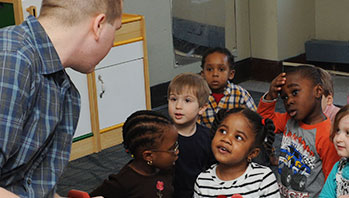- loud
- louder
- loudest
- quiet
- soft
- softer
- sound
- softest
MA Standards:
Speaking and Listening/SL.PK.MA.1: Participate in collaborative conversations with diverse partners during daily routines and play.
Language/L.PK.MA.1: Demonstrate use of oral language in informal everyday activities.
MA Draft STE Standards:
Physical Sciences/Matter and Its Interactions/PS4.B: Apply their understanding in their play of how to change volume and pitch of some sounds.
Head Start Outcomes:
Language Development/Receptive Language: Attends to language during conversations, songs, stories, or other learning experiences.
Language Development/Expressive Language: Uses language to express ideas and needs.
Logic and Reasoning/Reasoning and Problem Solving: Seeks multiple solutions to a question, task, or problem.
Logic and Reasoning/Reasoning and Problem Solving: Recognizes cause and effect relationships.
Science Knowledge/Scientific Skills and Method: Uses senses and tools, including technology, to gather information, investigate materials, and observe processes and relationships.
PreK Learning Guidelines:
English Language Arts/Language 2: Participate actively in discussions, listen to the ideas of others, and ask and answer relevant questions.
Science and Technology/Living Things and Their Environment 15: Use their senses of sight, hearing, touch, smell, and taste to explore their environment using sensory vocabulary.
Talk Together: Loud, Louder, Loudest

© Commonwealth of Massachusetts, Department of Early Education and Care (Jennifer Waddell photographer). All rights reserved.
STEM Key Concepts: Sounds have a source; An action has to happen to make a sound; Sounds vary in three ways: volume, pitch, and timbre; A sound becomes louder when the force of the action that is creating the sound is increased; A sound becomes softer, or quieter, when the force is decreased
ELA Focus Skills: Fine Motor Skills, Speaking and Listening, Vocabulary
Explain to children that you are going to review loud and quiet sounds with them.
- Invite two children to demonstrate while you review loud and quiet sounds. Have one child stomp loudly and one child stomp quietly. Ask, Who is making the loud stomping sound? How do you think Ilana makes the loud stomping sound?
- Ask three children to clap their hands. Have the first child give a loud clap. Then have another child give a louder clap. And finally have a third child give the loudest clap of all. Ask children to explain how they made their claps louder each time.
- Repeat with all the children clapping loud, louder, and loudest. Repeat again with soft, softer, softest.
